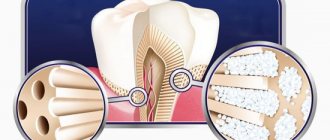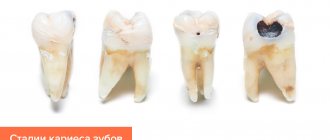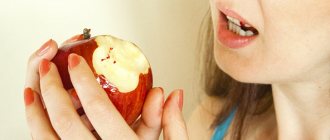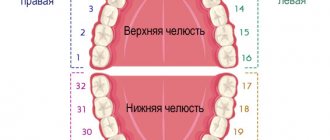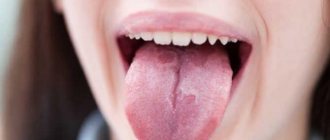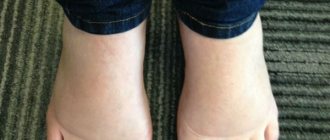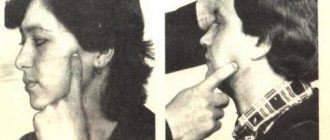Hyperesthesia is hypersensitivity of tooth enamel, manifested by short-term pain when exposed to external stimuli. Most often, symptoms are observed on the front teeth, which react painfully to biting, hot or cold. Increased sensitivity may manifest itself to sweet and sour foods, and discomfort occurs when brushing your teeth. Hyperesthesia must be combated, and the sooner treatment begins, the better. In advanced cases, the enamel is completely destroyed, and the affected teeth have to be removed. Let's try to figure out how to relieve increased sensitivity of teeth, what means are used for this, and how you can prevent the development of the disease.
Causes of tooth sensitivity
Hyperesthesia is the result of thinning or damage to the tooth enamel and its hard tissues, which leads to exposure of the tubules of the dentinal layer, which directly communicate with the pulp and nerves of the tooth. As a result of this, the slightest external impact on the tooth and its exposed tubules causes pain and discomfort.
Thinning or damage to tooth enamel occurs under the influence of internal and external factors. The main causes of this pathology are the following disorders and diseases.
- An unbalanced diet, depleted in vitamins and minerals.
- Hormonal disorders or uncontrolled use of hormone-containing drugs.
- Frequent infectious diseases.
- Chronic diseases of the gastrointestinal tract.
- Chronic stress or nervous disorders.
- Malocclusion.
- Abuse of foods high in acids.
- Use a toothbrush with stiff bristles.
- Do-it-yourself teeth whitening with dubious preparations.
- Pathological increased abrasion of tooth tissues.
- Wedge-shaped dental defects.
- Caries, periodontitis, pulpitis or erosion of tooth enamel.
- Bad habits - smoking, chewing hard nuts, grinding teeth, etc.
- Previously performed dental procedures - whitening, tartar removal, filling, prosthetics, etc.
In order to effectively relieve increased tooth sensitivity, it is necessary to accurately determine the cause of the pathology. Only by eliminating it can you get rid of pain, discomfort and other unpleasant sensations.
Causes of hyperesthesia
Dental hypersensitivity occurs under the influence of a complex of endogenous (internal) and exogenous (external) factors. Obvious causes of dental hypersensitivity include:
- carious lesions of tooth enamel;
- demineralization of enamel (loss of minerals);
- wedge-shaped defects of the tooth neck;
- pathological abrasion of teeth;
- periodontitis, periodontal disease;
- traumatic damage to teeth: chips, cracks, crown fracture.
Factors contributing to the occurrence of hyperesthesia are:
- Uncontrolled use of whitening toothpastes with a high RDA abrasiveness index: the higher it is, the larger the size of the grinding particles contained in the paste. With an RDA index of 100-200, toothpaste can be used no more than 1-2 times a week; if this rule is violated, the enamel becomes thinner. The chemical components of whitening pastes can wash out calcium from tooth enamel.
- Drinking sugary carbonated drinks and some fruit juices. Carbonated sweet water contains sugar and acid, which can destroy tooth enamel. Carbon dioxide also, with frequent consumption of soda, disrupts the structure of the enamel, so even unsweetened carbonated water should not be drunk too often. Such drinks are especially harmful to children's teeth.
Fruit acids contained in grapefruit, pineapple, pomegranate, grape and some other juices wash out minerals from tooth enamel, it becomes porous and reacts to various irritants.
- Poor dental care, which leads to deposits of plaque and tartar on them. Cariogenic microorganisms that live in dental plaque produce organic acids that destroy tooth enamel. This not only causes hypersensitivity, but also contributes to the development of caries.
- Professional teeth cleaning. The areas of enamel under dental plaque do not have sufficient amounts of calcium, fluoride and phosphorus necessary to protect teeth from external irritants. Tartar protects these areas from the action of various factors; when it is removed, the teeth become hypersensitive for a while. But teeth cleaning is necessary, so after it, the enamel is coated with remineralizing compounds.
- Poor nutrition. Lack of vitamins A, D, C, B vitamins, minerals, especially calcium and phosphorus in food, negatively affects the condition of the enamel. One of the reasons for sensitivity is the appearance of microcracks in the enamel as a result of simultaneous ingestion of cold and hot food.
- Endocrine and other diseases of the body. It has been established that endocrine diseases, such as thyroid disease, contribute to the development of hyperesthesia. Patients suffering from these ailments often develop wedge-shaped dental defects. Also, this pathology often occurs in parallel with diseases of the gastrointestinal tract.
- Bruxism. Grinding your teeth while you sleep leads to the abrasion of the enamel and the appearance of microcracks.
- Malocclusion. It also contributes to the appearance of areas on the teeth with increased abrasion, which react sharply to external irritants.
- Violation of teeth brushing technique. When brushing your teeth, you should not make horizontal movements, as this leads to wedge-shaped defects in the teeth.
- Menopause, pregnancy. These conditions are accompanied by changes in the hormonal levels of the body, which entails a violation of mineral metabolism: the enamel is demineralized.
Symptoms of sensitivity
The main sign of hyperesthesia is short-term toothache, which appears when eating cold, hot, sour, sweet, spicy food or when brushing your teeth. In this case, the pain can be mild and manifest itself in the form of minor discomfort, or it can be acute, very strong and throbbing. In both cases, it is felt for only a few seconds, after which it subsides and passes without a trace.
The pain that occurs with severe sensitivity can be local and affect only one or a few teeth, or be generalized - felt in most teeth or in all at once, which indicates the presence of caries, periodontal disease or exposure of the neck of the tooth.
According to clinical manifestations, it is customary to distinguish between three degrees of increased sensitivity of teeth.
- I degree – reaction of teeth to external temperature stimuli.
- II degree – reaction to temperature and chemical stimuli.
- III degree – reaction to temperature, chemical and tactile stimuli.
Pain is a constant companion of hyperesthesia and its main symptom. And even if it goes away for a while, and the patient can calmly eat cold, hot and other irritating foods, this does not mean that tooth sensitivity has gone away by itself. In this case, a peculiar period of remission has simply begun, which does not at all negate the mandatory treatment of the pathology.
Types of hypersensitivity
In 1981, Soviet dentists Yu. A. Fedorov and I. G. Lukomsky proposed a classification of dental hypersensitivity:
- According to the clinical course, they are distinguished:
- 1st degree of severity – the tooth reacts to temperature changes.
- 2nd degree of severity - the tooth reacts to temperature and chemical influences.
- 3rd degree of severity – sensitivity to mechanical stimuli is added.
- According to the area of distribution there are:
- Limited hyperesthesia, in which one or more teeth are sensitive.
- Generalized hyperesthesia - all teeth or most of them are sensitive.
- By nature of origin:
- With the loss of hard dental tissues (with caries, wedge-shaped defects, abrasion and erosion of enamel).
- Without loss of hard dental tissues (for periodontal diseases, functional disorders in the body).
Treatment at home
At home, you can use special medicinal varnishes, gels, powders or foams that help restore the protective properties of the enamel. Depending on the form of release, these products are applied to the surface of the teeth or used to prepare a solution for rinsing.
- Varnish Bifluoride 12.
- Fluocal gel or solution.
- The drug Fluorlak.
- Powder for preparing Remodent solution.
- Strontium chloride paste 75% or its 25% rinse solution.
- 10% calcium gluconate solution.
- Dental gel Tooth Mousse.
- Dental cream MI Paste Plus.
These products help reduce tooth sensitivity caused by internal disturbances in the body and slight thinning of tooth enamel. These medications can only be used after prior consultation with a dentist.
Preventive actions
To prevent the occurrence of hyperesthesia you need:
- monitor oral hygiene, master the technique of brushing teeth: when brushing the back and front surfaces of the teeth, brush movements should be vertical, from the base of the tooth to its edge, so that the brush “sweeps out” food debris;
- carry out professional oral hygiene in a dental clinic, which includes removal of dental plaque, remineralization therapy, individual selection of therapeutic and preventive means for the care of teeth and gums;
- When brushing your teeth, do not press hard on the toothbrush; the procedure time should not exceed 3 minutes;
- do not use brushes with hard bristles; When buying a brush, pay attention to the bristles - their ends should be rounded;
- do not use whitening pastes without consulting your dentist;
- treat caries and periodontal diseases in a timely manner;
- include foods rich in vitamins and minerals in your diet, and take vitamin-mineral complexes if necessary;
- Avoid eating cold and hot food at the same time;
- try to drink carbonated drinks through a straw;
- do not brush your teeth immediately after eating acidic foods, carbonated and fruit drinks, so as not to increase the leaching of calcium from the enamel; after taking them, rinse your mouth with clean water; you are allowed to brush your teeth only after half an hour;
- promptly treat non-dental diseases that may cause hyperesthesia.
Toothpastes and rinses
You can also reduce tooth sensitivity at home using special toothpastes and rinses.
- Oral-B Sensitive Original.
- Sensodyne-F.
- MEXIDOL dent Sensitive.
- Rembrandt Sensitive.
Pastes to reduce tooth sensitivity should be used during hygienic cleaning of the oral cavity, 2 times a day, morning and evening. To achieve a positive result, it is better to use them in a course – 1 – 2 times a year.
Important to remember! Therapeutic pastes, like varnishes, gels, powders and foams, are effective only in the absence of dental diseases.
Do not ignore preventive visits to the dentist.
It is enough to visit a specialist 1 – 2 times a year, which will allow you to promptly identify any dental problem at an early stage of development. This means that its elimination will be quick, easy and without complications.
By clicking the “request a call” button you agree to the personal data processing policy.
Complications
If increased tooth sensitivity occurs, patients try to injure them as little as possible during brushing, sometimes they refuse it, so the condition of the oral cavity gradually worsens. Over time, the amount of plaque on the teeth increases and tartar forms. Hard dental deposits contribute to the development of inflammation in periodontal tissues and the occurrence of caries. Periodontal disease leads to exposure of the roots of the teeth, resulting in increased sensitivity. It turns out to be a kind of vicious circle.
Treatment with folk remedies
You can also reduce tooth sensitivity using traditional methods. The following medicinal herbs and remedies are suitable for these purposes.
- Oak bark decoction for rinsing.
- Infusion or decoction of chamomile.
- Warm solution with 3 drops of natural tea tree oil.
- Warm salt solution for rinsing.
- Regular chewing of propolis.
- Regular use of warm fresh milk, which is kept in the mouth for 15 - 20 minutes.
Any folk remedy for tooth sensitivity should be used only if the enamel is slightly thinned. If there is a serious degree of pathology, you must immediately contact your dentist.
WHY ARE COMPLEX TEETH DONE IN PARTNER-MED?
We know how to work!
We have orthopedic dentists with 8-30 years of experience!
We love to work!
We will give you a free consultation and tell you exactly how best to make your teeth better!
We are responsible for the result!
We work conscientiously and will make your teeth LIKE YOURSELF!
In case of increased dental sensitivity caused by abrasion of enamel due to bruxism, first of all, the chewing load on the dentition is reduced with the help of disconnecting trays or splint systems. This is done by gnathologists. At the same time, exposed dentin in the chewing surface area and in wedge-shaped defects is isolated. Treatment of sensitive teeth ends with the application of fluoride varnish.
In some cases, a laser is used to reduce tooth sensitivity. Under the influence of laser coagulation, sintering and closure of dentinal tubules in the area of the dental neck occurs.
For any cause of dental hypersensitivity, it is mandatory to prescribe desensitizing pastes and rinses. It is better to entrust the selection of a remedy for tooth sensitivity to a dental hygienist who knows how to quickly relieve tooth sensitivity.
Treatment at the dentist
In most cases, hyperesthesia is caused by dental diseases. Therefore, it is not possible to get rid of the problem using home remedies or traditional medicine advice. In this case, home measures only aggravate the course of the pathology and lead to the progression of dental diseases.
You should not postpone a visit to the dentist even if there are minor manifestations of pain due to external stimuli. Modern medicine has effective methods for treating any dental ailment. After a thorough diagnosis of the condition of the teeth, an experienced specialist will accurately determine the cause of increased sensitivity and carry out the necessary treatment. This may be the elimination of wedge-shaped tooth defects, treatment of caries, periodontitis, pulpitis or erosion of tooth enamel. In the absence of serious diseases, the dentist can perform a competent procedure for remineralization of teeth, which will strengthen tooth enamel and relieve hypersensitivity.
Hypersensitivity is not a dental disease, but rather a symptom indicating the presence of dental disease. And the sooner you contact a specialist, the greater the chance of maintaining the health and integrity of your teeth.
Causes and forms of manifestation of excessive sensitivity
Discomfort with this pathology is caused by a constant feeling of fear of severe pain from the simplest, most familiar actions. Excessive sensitivity of all or individual teeth appears when dentin is exposed, caused by various reasons:
- too aggressive cleaning;
- using an excessively hard brush;
- bruxism or teeth grinding;
- temporary specific reaction to professional teeth cleaning and whitening;
- consequence of dental treatment.
When sensitivity increases, irritants are usually physical factors - heat, cold, mechanical stress, acidic foods and foods rich in simple carbohydrates.
The porous dentin tissue contains special microchannels leading to the dental nerve; when they are exposed as a result of enamel erosion or receding gums, impulses arise that cause a pain response from the teeth.
Teeth sensitivity after whitening
The appearance of hyperesthesia after the whitening procedure is a fairly common complaint from patients. As a rule, this is associated with the use of aggressive abrasive “miracle products” or low-quality preparations based on hydrogen peroxide. Both of them wear away tooth enamel and cause increased sensitivity to irritants.
Teeth whitening is a dental procedure. Therefore, it should be carried out by professional dentists. They will tell you in detail how to prepare your teeth for whitening, how to care for your mouth after the procedure, and will carry out the necessary whitening using safe preparations and techniques.
Symptoms and diagnosis of hyperesthesia
Dental hypersensitivity is characterized by a sudden sharp or aching pain, a sore throat when the tooth is exposed to any irritant: when taking sweet, sour, salty, cold or hot liquid, food; when brushing your teeth. After eliminating the irritant, the pain quickly goes away.
Women are most susceptible to hyperesthesia; In the population over the age of 60, hypersensitivity reactions become less pronounced due to the aging of dentin.
The diagnosis of hyperesthesia is made based on a conversation between the dentist and the patient and examination of the oral cavity. If a doctor directs a stream of air or water onto hypersensitive teeth, the patient immediately reacts with a shudder, his face expresses pain, and he reports his sensations.
Sensitivity of teeth after filling
Increased sensitivity may appear after the filling is placed. This is due to the use of 38% phosphoric acid during the procedure. It is used to treat the surface of the tooth at the site where the filling is applied to achieve reliable fixation of the filling material. But, unfortunately, this acid makes tooth enamel porous, exposing the tubules of the dentinal layer. Therefore, in order to avoid unpleasant painful sensations after filling, it is recommended to strictly follow all the recommendations of the treating dentist - they will help restore the protective functions of the enamel.
Tooth sensitivity during pregnancy
The appearance of hyperesthesia during pregnancy is the first sign of thinning of tooth enamel due to a lack of vitamins and essential minerals. In this case, you need to review your daily diet in favor of foods high in vitamin D, C, calcium and magnesium. It is also necessary to limit the consumption of foods that contain large amounts of acids. And in order to prevent the development of possible diseases, you should consult a dentist or have your teeth remineralized.
Sensitivity of teeth to cold and hot
Painful symptoms when eating cold or hot food are the first sign of hyperesthesia. In this case, we are talking about the first degree of hypersensitivity, which can be caused by thinning of tooth enamel or more serious diseases, for example, caries. Therefore, you should not put off visiting the dentist. For minor problems, he will recommend effective home remedies to reduce sensitivity. And if there is a disease, he will provide adequate dental treatment.
What to do if you lose tooth enamel?
The problem is not always solved by remineralization and dental varnish. In cases where the enamel is worn out or severely cracked, gentle methods will not help. Modern dentistry offers several solutions with complete or partial preservation of the tooth:
- Veneers and lumineers are the most expensive method; they provide good protection, but do not restore chewing functions.
- Ceramic or zirconium crowns are strong and durable. Requires preliminary preparation of the support.
- Artistic restoration - new generation composite materials are practically indistinguishable from the natural shade, but last a maximum of 10 years.
Prevention and recommendations from dentists
In order to avoid the occurrence of increased tooth sensitivity and its unpleasant symptoms, the following simple recommendations should be followed.
- Balance your diet in favor of foods high in vitamin D, C, calcium, magnesium and phosphorus.
- Strengthen your body's immunity.
- Monitor the formation of correct bite in children.
- Limit consumption of foods high in acids.
- Use medicated toothpastes and soft-bristled brushes.
- Do not attempt to whiten your teeth on your own.
- Regularly remove tartar and hard deposits from your dentist.
Increased sensitivity of teeth is classified as a pathology that is much easier to prevent than to eliminate. To do this, you need to regularly, 1 – 2 times a year, undergo a preventive examination with a dentist. A specialist will be able to identify possible dental problems and provide timely treatment. Your teeth will be healthy and will not cause pain when eating your favorite foods.
Author: Elena Grunina Dentist-therapist, endodontist. Work experience more than 9 years.
The information is for reference only. Before treatment, consultation with a doctor is necessary.
Treatment of hyperesthesia
Treatment of hyperesthesia is divided into two types:
- Pathogenetic therapy is aimed at treating diseases that cause increased sensitivity of teeth:
- Wedge-shaped defects are filled and caries is treated. In the presence of microcracks, chips and erosions of the enamel, the defects are closed with the help of veneers, crowns and filling materials.
- In the absence of pathologies of dental tissues, or if caries is in the white spot stage, remineralization (calcium saturation) and fluoridation of tooth enamel is carried out: it is treated with special preparations in a dental clinic.
- They remove dental deposits and cover the necks of teeth with remineralizing compounds.
- Orthodontic treatment is carried out if the cause of hyperesthesia is tooth abrasion due to malocclusion.
- Treatment of the main non-dental diseases that cause hyperesthesia is carried out.
- Symptomatic therapy – helps eliminate or reduce pain. For this use:
- toothpastes and rinses for sensitive teeth;
- soft toothbrushes;
- remineralizing gels for home use;
- electrophoresis of teeth with calcium preparations, sodium fluoride, lidocaine.
In addition to calcium and fluoride, oral care products for hyperesthesia include citrates and strontium compounds; their therapeutic effect is the restructuring and compaction of the dentin structure, clogging of the dentinal tubules, which leads to a decrease in sensitivity.
When using potassium salt preparations, sensitivity is reduced by blocking the transmission of nerve impulses in the dentinal canals.
Toothpastes for sensitive teeth also contain hydroxyapatite, a component of tooth tissue; When cleaning, it covers the enamel with a protective film.
